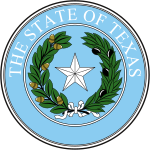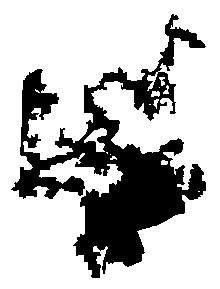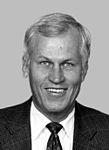1992 United States House of Representatives elections in Texas
Majority party
Minority party
Party
Democratic
Republican
Last election
19
8
Seats won
21
9
Seat change
Popular vote
2,806,044
2,685,973
Percentage
49.9%
47.8%
Swing
Election results by district Election results by county
Democratic
50–60%
60–70%
70–80%
80–90%
90>%
Republican
50–60%
60–70%
70–80%
80–90%
90>%
The 1992 United States House of Representatives elections in Texas occurred on November 3, 1992, to elect the members of the state of Texas's delegation to the United States House of Representatives . Texas had thirty seats in the House, apportioned according to the 1990 United States census .[ 1]
Intraparty conflict embroiled the Texas Democratic Party , who had gained complete control of Texas' government following Ann Richards ' victory in the 1990 gubernatorial election .[ 2] Eddie Bernice Johnson chaired the redistricting subcommittee and drew maps with the intention of creating minority-majority districts in Dallas for herself to run in.[ 3] [ 4] Martin Frost and John Wiley Bryant , whose districts would become considerably more White and Republican-leaning as a result. A majority-Hispanic district was also created in Houston alongside District 18 , a plurality-Black district. The Texas Legislature sided with Johnson's plan and adopted new congressional districts during a special session in 1991.[ 5] [ 6]
These elections occurred simultaneously with the United States Senate elections of 1992 , the United States House elections in other states, the presidential election , and various state and local elections. As of 2020 , this is the last time the Democratic Party won the popular vote in Texas's U.S. House races,[ 7] 2004 .
1992 United States House of Representatives elections in Texas[ 8]
Party
Votes
Percentage
Seats before
Seats after
+/–
Democratic
2,806,044
49.91%
19
21
+2
Republican
2,685,973
47.77%
8
9
+1
Libertarian
110,832
1.97%
0
0
-
Independent
19,623
0.35%
0
0
-
Totals
5,622,472
100.00%
27
30
+3
Congressional districts [ edit ] Incumbent Democrat Jim Chapman ran for re-election unopposed.
1992 Texas's 2nd congressional district election
County results Wilson: 50–60% 60–70%Peterson: 40–50% 50–60%
Incumbent Democrat Charlie Wilson ran for re-election.
Incumbent Republican Steve Bartlett resigned in 1991 after he was elected Mayor of Dallas .[ 9] special election to be held, which fellow Republican Sam Johnson won in a runoff.[ 10]
Incumbent Democrat Ralph Hall ran for re-election.
1992 Texas's 5th congressional district election
County results Wilson: 50–60% 60–70% 70–80%
Incumbent Democrat John Wiley Bryant ran for re-election.
Incumbent Republican Joe Barton ran for re-election.
Incumbent Republican Bill Archer ran for re-election unopposed.
Incumbent Republican Jack Fields ran for re-election.
Incumbent Democrat Jack Brooks ran for re-election.
Incumbent Democrat J. J. Pickle ran for re-election.
1992 Texas's 11th congressional district election
County results Edwards: 60–70% 70–80%
Incumbent Democrat Chet Edwards ran for re-election.
Incumbent Democrat Pete Geren ran for re-election.
1992 Texas's 13th congressional district election
County results Sarpalius: 50–60% 60–70% 70–80% 80–90%Boulter: 50–60%
Incumbent Democrat Bill Sarpalius ran for re-election. Beau Boulter , who held the seat until 1989, ran against him.
1992 Texas's 14th congressional district election
County results Laughlin: 50–60% 60–70% 70–80% 80–90%Garza: 50–60%
Incumbent Democrat Greg Laughlin ran for re-election.
Incumbent Democrat Kika de la Garza ran for re-election.
Incumbent Democrat Ronald D. Coleman ran for re-election.
1992 Texas's 17th congressional district election
County results Stenholm: 50–60% 60–70% 70–80%
Incumbent Democrat Charles Stenholm ran for re-election.
Incumbent Democrat Craig Washington ran for re-election. The district was intentionally drawn to have an African-American majority population, but the methods used to draw this district would be found unconstitutional by the Supreme Court case Bush v. Vera in 1996.[ 11]
Incumbent Republican Larry Combest ran for re-election.
Incumbent Democrat Henry B. González ran for re-election unopposed.
Incumbent Republican Lamar Smith ran for re-election.
Incumbent Republican Tom DeLay ran for re-election.
Incumbent Democrat Albert Bustamante ran for re-election.
Incumbent Democrat Martin Frost ran for re-election.
Incumbent Democrat Michael A. Andrews ran for re-election.
Incumbent Republican Dick Armey ran for re-election.
Incumbent Democrat Solomon Ortiz ran for re-election.
District 28 was created as a result of redistricting after the 1990 census .
District 29 was created as a result of redistricting after the 1990 census . The district was intentionally drawn to have a Hispanic majority population, but the methods used to draw this district would be found unconstitutional by the Supreme Court case Bush v. Vera in 1996.[ 11]
Outline of Texas' 30th Congressional District in 1992. District 30 was created as a result of redistricting after the 1990 census . The district was intentionally drawn to have an African-American majority population, but the methods used to draw this district would be found unconstitutional by the Supreme Court case Bush v. Vera in 1996.[ 11] Eddie Bernice Johnson , the first African American woman ever elected to public office from Dallas , ran in the open race.[ 12]
^ "1990 Census Apportionment Results" . Census.gov . Retrieved June 14, 2022 .^ Kennedy, J. Michael (November 7, 1990). "Democrat Richards Wins Bitter Contest With Williams : Texas: The governor's race was the state's longest, most expensive and perhaps most rancorous. GOP oilman's verbal gaffes damaged his chances" . Los Angeles Times . Retrieved August 2, 2022 . ^ Burka, Paul; Hart, Patricia; October 1991 0, Ellen Williams (October 1, 1991). "1991: The Best and the Worst Legislators" . Texas Monthly . Retrieved August 2, 2022 . {{cite web }}: CS1 maint: numeric names: authors list (link )^ Burke, Anabel. "Eddie Bernice Johnson" . Waco History . Retrieved August 2, 2022 . ^ Edsall, Thomas (May 21, 1991). "TEXAS REDISTRICTING A CASE STUDY OF DEMOCRATS' STRUGGLE" . The Washington Post . Retrieved August 2, 2022 . ^ "History" . redistricting.capitol.texas.gov . Retrieved June 17, 2022 .^ Bickerstaff, Steve (2007). Lines in the Sand: Congressional Redistricting in Texas and the Downfall of Tom Delay . Austin, Texas: University of Texas Press. p. 29. ISBN 978-0-292-71474-8 ^ a b c d e f g h i j k l m n o p q r s t u v w x y z aa ab ac ad ae "1992 General Election" . elections.sos.state.tx.us . Retrieved June 16, 2022 .^ "Inaugural Speech of Mayor Steve Bartlett and Farewell Address of Mayor Annette Strauss, 1991" . dallascityhall.com . Retrieved June 17, 2022 .^ "CQ Politics in America Profile: Sam Johnson" (PDF) . Congressional Quarterly . May 7, 2013. Retrieved April 25, 2018 .^ a b c "Bush v. Vera, 517 U.S. 952 (1996)" . Justia Law . Retrieved June 16, 2022 .^ "Eddie Bernice Johnson (1935- ) •" . October 7, 2017. Retrieved June 16, 2022 .
General President of the U.S. President U.S. Senate
U.S. House Governor Legislature
1992
1994
1996
1998
2000
2002
2004
2006
2008
2010
2012
2014
2016
2018
2020
2022
2024
Lieutenant Governor Attorney General Amendments Municipal
Dallas El Paso Houston Plano
Mayoral
Arlington Austin Corpus Christi Dallas El Paso Fort Worth Houston Laredo Lubbock San Antonio


















